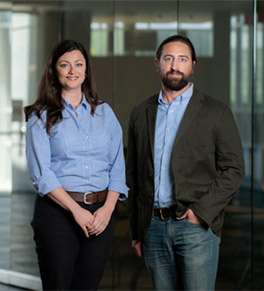Breast atlas: a roadmap to breast health

Mapping normal human breast cells may shed light on how they can change and become cancer, say UCI scientists Devon Lawson, left, and Kai Kessenbrock. Photo by Steve Zylius/UCI
UC Irvine researchers who helped create the first comprehensive cellular map of the human female breast say it will greatly improve our understanding of breast diseases and may help identify future targets for breast cancer therapies.
Dubbed the Human Breast Cell Atlas, this national project already has produced some startling findings that raise questions about breast function over a lifespan. The study, which is supported by the Chan Zuckerberg Initiative, was published last June in the science journal Nature.
One focus of the Chan Zuckerberg Initiative is to map every cell in the human body, says Devon Lawson, PhD, associate professor of physiology and biophysics at the UCI School of Medicine, co-author of the breast atlas and a researcher with the UCI Health Chao Family Comprehensive Cancer Center.
“The idea was that if you can understand what normal cells are doing in tissues, you can understand how things can change and go wrong. We now have this map of healthy breast tissue — of every type of cell, where they are and what they do.”
Seven-year study
She and co-author Kai Kessenbrock, PhD, associate professor of biological chemistry, had already been conducting breast cell research when they met Nicholas Navin, PhD, a cancer geneticist at the University of Texas MD Anderson Cancer Center, at a Chan Zuckerberg Initiative conference.
They formed a team, received a grant and began analyzing normal human breast tissue more than seven years ago.
Over that period, they analyzed tissue from women of various ages and ethnicities and profiled more than 714,000 cells. Although the human body has about 200 types of cells, only 12 are found in normal breast tissue. The atlas highlights these 12 major cell types and their 58 biological cell states.
“Biologically, the breast is of interest for both normal function and disease functions,” says Lawson, noting its basic function is to secrete milk but that the organ’s cells also are prone to cancer.
Immune cell surprise
Epithelial breast cells, which can give rise to cancer, have been studied extensively. The atlas also focuses on other cells, such as lymphatic cells, vascular cells, B cells and mast cells.
Researchers also discovered that 16.7% of normal breast cells were types of immune cells, which they had not realized were so abundant.
“We were surprised that there were so many immune cells,” Lawson says.
“What are they doing there? We have some good ideas that they may function to maintain normal breast homeostasis — for example, how the breast grows in pregnancy and then shrinks again. A lot of our future work will be to assess what these immune cells do.”
Cellular differences in Black women
Their findings are of particular value for Black women, who are at higher risk for aggressive triple-negative breast cancer.
The atlas showed that Black women have higher frequencies of several epithelial and immune cell states that may play a role in this predisposition for triple-negative breast cancer, Lawson says. Further research is needed to investigate the biological implications of these observed differences.
Lawson says much of the work was made possible because of the Chao Family Comprehensive Cancer Center’s emphasis on genomic sequencing, which enabled their team to perform the advanced work needed for the breast tissue studies.
“The technology is advancing so quickly, every year there are new ways to sequence faster and better,” she adds. “UCI has put a lot of effort and resources into genomics, which enabled us to push forward with the most cutting-edge approaches.”




